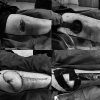Incisional negative pressure therapy reduces complications and costs in pressure ulcer reconstruction
- PMID: 30548531
- PMCID: PMC7948904
- DOI: 10.1111/iwj.13045
Incisional negative pressure therapy reduces complications and costs in pressure ulcer reconstruction
Abstract
Complications after pressure ulcer reconstruction are common. A complication rate of 21% to 58% and a 27% wound recurrence has been reported. The aim of this study was to decrease postoperative wound-healing complications with incisional negative pressure wound therapy (iNPWT) postoperatively. This was a prospective non-randomised trial with a historic control. Surgically treated pressure ulcer patients receiving iNPWT were included in the prospective part of the study (Treatment group) and compared with the historic patient cohort of all consecutive surgically treated pressure ulcer patients during a 2-year period preceding the initiation of iNPWT (Control). There were 24 patients in the Control and 37 in the Treatment groups. The demographics between groups were similar. There was a 74% reduction in in-hospital complications in the Treatment group (10.8% vs 41.7%, P = 0.0051), 27% reduction in the length of stay (24.8 vs 33.8 days, P = 0.0103), and a 78% reduction in the number of open wounds at 3 months (5.4 vs 25%, P = -0.0481). Recurrent wounds and history of previous surgery were risk factors for complications. Incisional negative pressure wound therapy shortens hospital stay, number of postoperative complications, and the number of recurrent open wounds at 3 months after reconstructive pressure ulcer surgery, resulting in significant cost savings.
Keywords: cost; flap; negative pressure; pressure ulcer; reconstruction.
© 2018 Medicalhelplines.com Inc and John Wiley & Sons Ltd.
Figures
References
-
- Stillman MD, Barber J, Burns S, Williams S, Hoffman JM. Complications of spinal cord injury over the first year after discharge from impatient rehabilitation. Arch Phys Med Rehabil. 2017;98(9):1800‐1805. - PubMed
-
- Brienza D, Krishnan S, Karg P, Sowa G, Allegretti A. Predictors of pressure ulcer incidence following traumatic spinal cord injury: a secondary analysis of a prospective longitudinal study. Spinal Cord. 2018;56(1):28‐34. - PubMed
-
- Le Fort M, Espagnacq M, Perrouin‐Verge B, Ravaud J. Risk analyses of pressure ulcer in tetraplegic spinal cord‐injured persons: a French long‐term survey. Arch Phys Med Rehabil. 2017;98(9):1782‐1791. - PubMed
-
- Wurtzer P, Winter R, Stemmer SO, et al. Lomenta DB: risk factors for recurrence of pressure ulcers after defect reconstruction. Wound Repair Regen. 2018;26(1):664‐668. - PubMed
-
- Kwok A, Simpson A, Willcockson J, Donato D, Goodwin I, Agarwal J. Complications and their associations following the surgical repair or pressure ulcers. Am J Surg. 2018;Pii:S0002‐9610(17)31486‐1. - PubMed
MeSH terms
LinkOut - more resources
Full Text Sources
Medical


